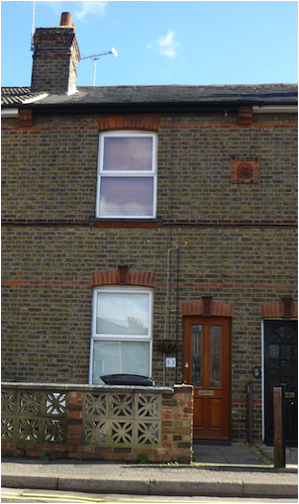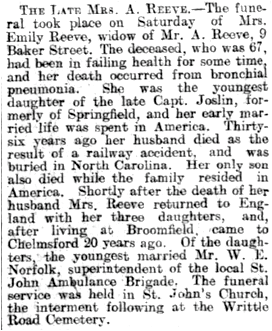Frederick Albert Reeve was brought up in the Moulsham area of Chelmsford by his widowed mother. During the war he served with the Essex Regiment and was killed in Monchy-le-Preux in April 1917. His home was in Baker Street.
REEVE, FREDERICK ALBERT,
Private, 1st Battalion, Essex Regiment
Captain Carolin, who had come in badly wounded, gave useful information to Battalion headquarters, especially concerning the concentration of Germans in the Bois du Sart. The destruction of the signal wires caused an hour’s delay in communicating with the artillery and thus hindered the break-up of the enemy formations. Relays of orderlies were sent to Brigade headquarters with urgent requests for artillery aid and later on two of them were found killed by shell-fire with their messages upon them.
X Company, Essex Regiment, detailed as flank guard on the left, quickly came into contact with the enemy. Under Capt. Foster prompt measures were taken to push forward. No. 8 platoon was checked by machine guns located in Arrow Head Cops, and whilst No. 5 platoon opened covering fire fron a line of shell holes, No. 7 platoon outflanked the copse, with the result that No. * again moved forward, capturing two machine guns and driving the enemy out of his position. A small wood was also in hostile occupation, but was cleared by Lewis guns and rifle grenades. Pressing forward to the northern end of Twin Copses the Company came under fire from a line of hidden machine guns and replied by establishing a chain of strong points.
From that time forward, however, the situation rapidly became critical. Heavy enemy artillery fire had been opened upon Monchy - which was almost levelled in a few hours - and the batteries on the Feuchy Chapel - Feuchy Road, covering an attack which developed mainly from Bois du Sart and the valleys north-east of the town. X Company were overwhelmed some time between 6.30 and 7.30, and by the latter hour the main attack had culminated against the front line companies.
The fighting was obstinate and men of Essex and Newfoundland suffered severely, but although practically destroyed as battalions their resistance broke the offensive if a German division. A few men dribbled in from X Company and were quickly organised for defence under the Adjutant (Lieut. C. P. Lawson) and Sergeant-Major Bailey, but from 7.30 a.m. onwards no messages arrived at Battalion headquarters nor did any more wounded report at the aid post,
Essex headquarters personnel and Battalion reserve manned street barricades in Monchy. A small part of the enemy’s force maintained its advance to the outskirts of the town, but got no farther. Headquarters of the Newfoundland at 11.30 a.m. held the south-eastern corner of Monchy and from a trench close to a garden fence brought machine-gun fire to bear on the enemy reoccupying Shrapnel Trench; 88th Brigade M.G.C. knocking out a German machine gun by fire from the Central Road east of Monchy.
At 1.30 p.m. a strong enemy force unsuccessfully struck against the line held by the Worcesters. The Hampshires were moved into Monchy at 5 p.m. and the Lancashire Fusiliers to the position the former vacated. The enemy made two more attacks in the afternoon, accompanied by destructive shell fire, but they died down and ay night the hardly-tried troops were relieved by the 86th Brigade.
From a study of the two Battalions [Essex and Newfoundland] narratives it would appear that shortly after 7.30 a.m. the Germans attacked the British left in overwhelming force and rolling up the Essex line, after a desperate resistance, swept across the front and destroyed the gallant Newfoundlanders.
The Essex and Newfoundland men had achieved a great feat of arms....the 29th Division Commander reported: ‘There is no question that the assault delivered by the Newfoundland and 1st Essex Regiments forestalled and disorganised a serious attempt by the enemy to capture Monchy’.”

Frederick was born in Main Road, Broomfield in 1897, the only son of Arthur Reeve and Emily Reeve (nee Joslin). His mother had been born around 1867 in Rotherhithe, London. His maternal grandfather was a master mariner Captain Charles Isaac Joslin (1836-1912) who had been born in Chelmsford.
Frederick had three elder sisters: Nellie Reeve (born in Writtle in 1887, died in 1946), Louise E. Reeve (born in Florida c1893, died in 1965), and Alice Mary Reeve (born in Florida in 1895, died in 1978). His parents had spent some of their early married life in the United States, and it was there that Frederick’s father died in a railway accident in North Carolina around 1887. After his father’s death his mother had brought the family back to England to settle in Broomfield.
The 1901 census found three year-old Frederick living with his widowed mother and three sisters at Main Road, Broomfield.
A decade later the 1911 census recorded 13 year-old Frederick and his mother boarding with John Smith and his family at 9 Stamford Terrace, Baker Street in Chelmsford (later known as 9 Baker Street and today’s number 53 Baker Street).
Frederick enlisted at Chelmsford and served as Private 32991 with the 1st Battalion of the Essex Regiment, part of the 88th Brigade in the 29th Division. The battalion had, from July 1916 until November 1916, fought in the Battle of the Somme. By April 1917 it had left
the Somme area and moved northwards to participate in the Battle of Arras. The battle commenced on Easter Monday, 9th April 1917 when Allied troops launched an offensive along a wide front which despite early progress failed to achieve the breakthrough they coveted.
On 12th April 1917 Frederick’s battalion completed a 20 mile march to arrive in Arras. From there, along with the rest of the 88th Brigade, it moved overnight four miles eastwards to relieve comrades in the 37th Brigade near the village of Monchy-le-Preux, Pas de Calais, France, where it arrived at 3 a.m. on 13th April 1917. A proposed early morning attack by the battalion on German positions was postponed just five minutes before zero hour. Another attack, planned for 2 p.m. was also cancelled a few minutes before the hour fixed. Nevertheless it was finally agreed to launch the attack in the early morning of 14th April 1917.
A post-war account of the battalion recorded the following for 14th April 1917:
“The effort was directed against the higher ground about a thousand yards east of Monchy, to be known later as Infantry Hill. with last minute instructions to the battalion on the right to occupy Bois du Vert should the barrage have driven the enemy therefrom. Strong points were to be constructed on both flanks. ‘The result of this operation, if successful, would be a position balloon shaped. as if blown from Monchy-le-Preux, which was the apex of a salient..’ The capture of the hill would afford observation over the Douai plain.
Two battalions were alloted to the offensive - Newfoundlanders on the right (C and D Companies in the front line, with B in support and A as flank guard) and Essex on the left (three companies. W Capt. R. E. G. Carolin; U Capt. Tomlinson, and Z Capt. C. R. Brown M.C,, with X Company (Capt. H. J. B. Foster) as flank guard. 4th Worcesters were in support on the line vacated by the assaulting force and reaching to the Cambrai road. 2nd Hampshires were in reserve between Orange Hill and Monchy, with one company pushed forward to the north-eastern edge of the town, in alignment with the Worcesters.
The attack was launched at 5.30 a.m. under a creeping barrage commencing 200 yards from the enemy’s front line and lifting 100 yards every four minutes. There were also macine gun barrages on the flanks and four mobile machine guns accompanied the assaulting troops. It was a misty morning, with the wooded ground wet and heavy from recent rain and snow.
Essex rapidly advanced by short rushes and by 6.30 were reported to be digging in and to have taken a few prisoners. A patrol of four Newfoundlanders, taken out by an Essex officer, killed four Germans in a gunpit 100 yards in front of the final objective. The Germans had retired from Shrapnel Trench as soon as the barrage opened, though some trouble was caused by fire from an unlocated trench on the right. Patrols were sent forward to ascertain whether the enemy were in possession of Bois du Sart and Bois des Aubepines, and these reported that large masses of troops could be observed therein obviously preparing for the counter-attack. C

But it was at a heavy price. Frederick’s battalion had gone into action with 31 officers and 892 other ranks, of who at the end of the day 17 officers and 644 other ranks were reported to be either killed, wounded or missing. 203 of the missing were later confirmed to be prisoners of war. The Newfoundlanders reported 487 casualties out of 591 officers and men employed.
Among the 644 Essex casualties was Frederick, aged 19, who was subsequently presumed to have been killed in action. Frederick has no known grave and is commemorated on the Arras Memorial, Pas de Calais in France, on the Civic Centre Memorial, Chelmsford, and the Moulsham Parish Memorial, St John’s Church, Moulsham. He was entitled to the British War Medal and Victory Medal.
Another Chelmsford man, Robert Acfield Gibbons, also died on 14th April 1917 while serving with the 1st Battalion of the Essex Regiment at Monchy-le-Preux.
On 15th February 1918 the Essex County Chronicle reported:
“Mrs. Reeve, of Baker Street, Chelmsford, has been informed that her only son, Pt. F. A. Reeve, Essex Regt., reported missing on April 14, 1917, is now presumed to have died on that date. He was 19 years of age.”
Frederick’s mother lived at 9 Baker Street until her death in 1934. The property was renumbered 53 in 1957.
140302